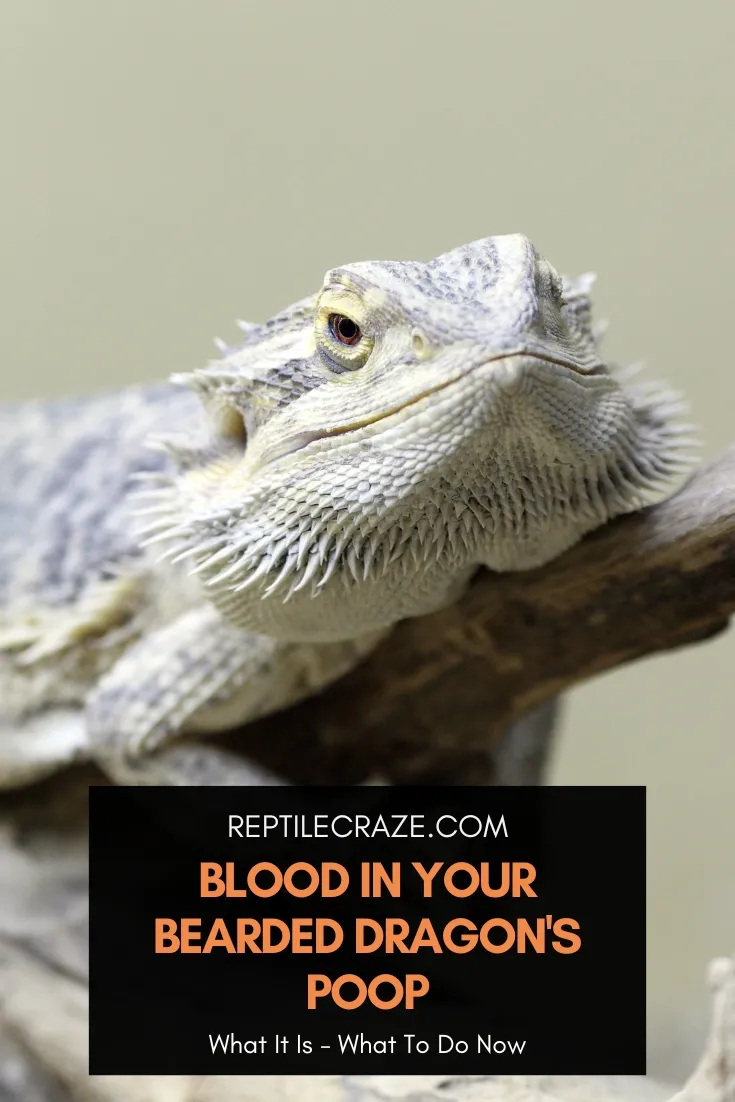
Seeing some red color in your bearded dragon’s poop can be very scary. You may start freaking out and wondering whether your pet is gravelly ill or if it is bleeding internally. But, should you really be worried if you notice some blood in your pet’s poop? Is there something you can do to help your bearded dragon to stop bleeding?
Blood in your bearded dragon’s poop can happen for many reasons, including infections by viruses, bacteria, or parasites. Other causes include constipation, impaction, prolapse, or even internal injuries.
However, some red color in your pet’s poop is not always caused by bleeding; sometimes, it can happen due to the natural color of certain foods, like raspberries. So, what should you do if you notice some red color or blood in your bearded dragon’s poop? Keep reading to find it out!
What Are The Causes Of Blood In Your Beardie’s Poop?
Under normal conditions, your bearded dragon’s feces (poop) should be dark brown with a white edge. The brown part is the fecal matter (digested
Sometimes, what you think may be blood in your bearded dragon’s feces, ends up being just red color from some foods that your beardie ate earlier, such as raspberries or beet.
However, when in doubt, check your beardie’s poop for a couple of depositions so you can monitor if you can still see more red color in it.
Keep in mind that when a bearded dragon is bleeding from the lower part of its intestines or from its anus, you will be able to see blood that looks fresh and has a bright red color.
Otherwise, if the beardie is bleeding from its upper digestive tract, such as its mouth or stomach, you will notice the blood is dark red.
There are numerous problems that can cause your bearded dragon to start having blood in its feces.
Some of these health problems are not harmful in the long term for your pet’s well-being, but some can be very serious and require immediate assistance.
Let’s take a look at the most common causes of blood in your beardie’s poop:
Parasites
Parasites like oxyurids (pinworms) and coccidia are usually found in bearded dragons and are the culprits of bloody feces in most cases.
Pinworms
Pinworms are the most frequent type of parasite found in beardies. When low numbers of pinworms are found in a healthy bearded dragon, the infection can be left untreated.
However, if a beardie is having health issues and the number of pinworms found in its feces is high, then, treatment is always warranted.
It is important to notice that poor husbandry conditions are one of the most common reasons for constant and significant pinworm infections in an otherwise healthy bearded dragon.
Besides bloody stool, other signs of pinworm infection can include:
- Anal bleeding
- Diarrhea (Read our article on beardie diarrhea here)
- Weight loss
- Refusal to eat
- Failure to thrive
If you believe your pet may have a pinworm infection, you can take a stool sample to the vet for examination. Keeping the enclosure clean is imperative to prevent your beardie from getting infected again.
Treatment is done with deworming drugs, and a repeat stool analysis is recommended two weeks after the treatment was completed to see if it was successful in eliminating the parasites.
Tip: Parasites can also cause your beardie’s poop to be white. We created an article on white beardie poop and what to do about it here.
Coccidia
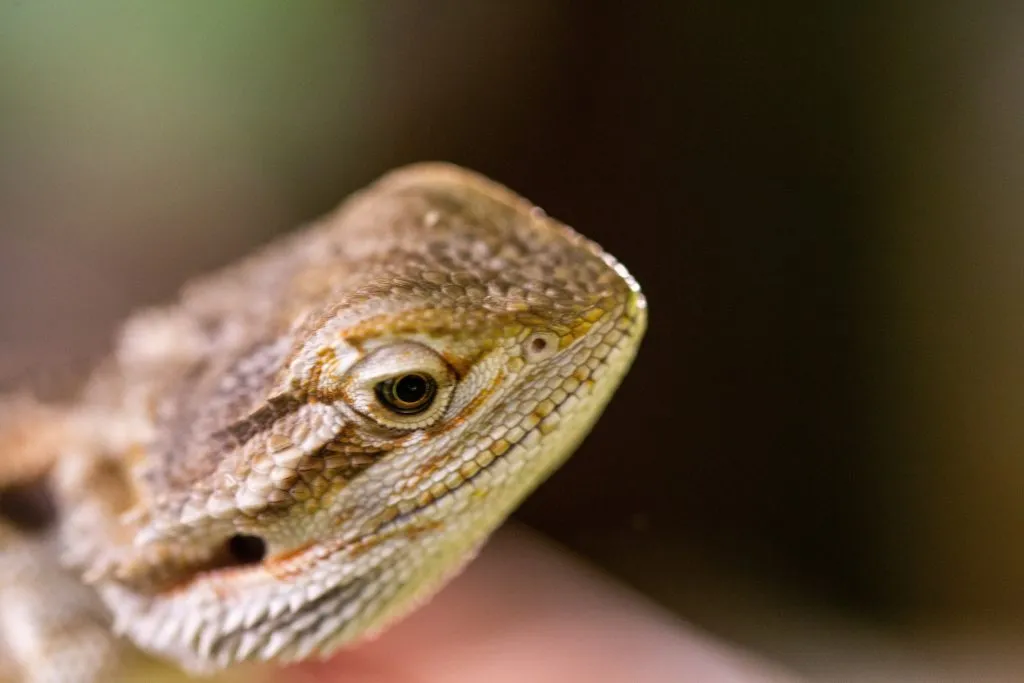
Coccidia is another common parasitic infection found in bearded dragons. In this case, treatment should be always administered when these parasites are found on the beardie’s poop, whether the reptile is symptomatic or not.
Nevertheless, once a bearded dragon gets infected with this parasite, achieving complete clearance is very difficult.
Signs of coccidia infection may include:
- Diarrhea
- Bloody stool
- Failure to thrive
- Weight loss
- Neurological signs, such as tremors
In case you suspect your pet has a coccidia infection, take a stool sample to the vet and immediately start removing your beardie’s feces from the enclosure as soon as he or she poops. This will help reduce future flare-ups.
Also read: Why Your Beardie’s Poop Is Green
Bacterial Or Viral Infection
Certain types of viruses and bacteria can infect your bearded dragon and cause a gastrointestinal infection, which can result in bloody feces in some cases.
Your beardie may become infected by eating contaminated foods, such as unwashed vegetables or leafy greens.
Always wash and sanitize all
If you suspect your beardie may have a viral or bacterial infection, you should take it to the vet for testing and further evaluation.
Constipation
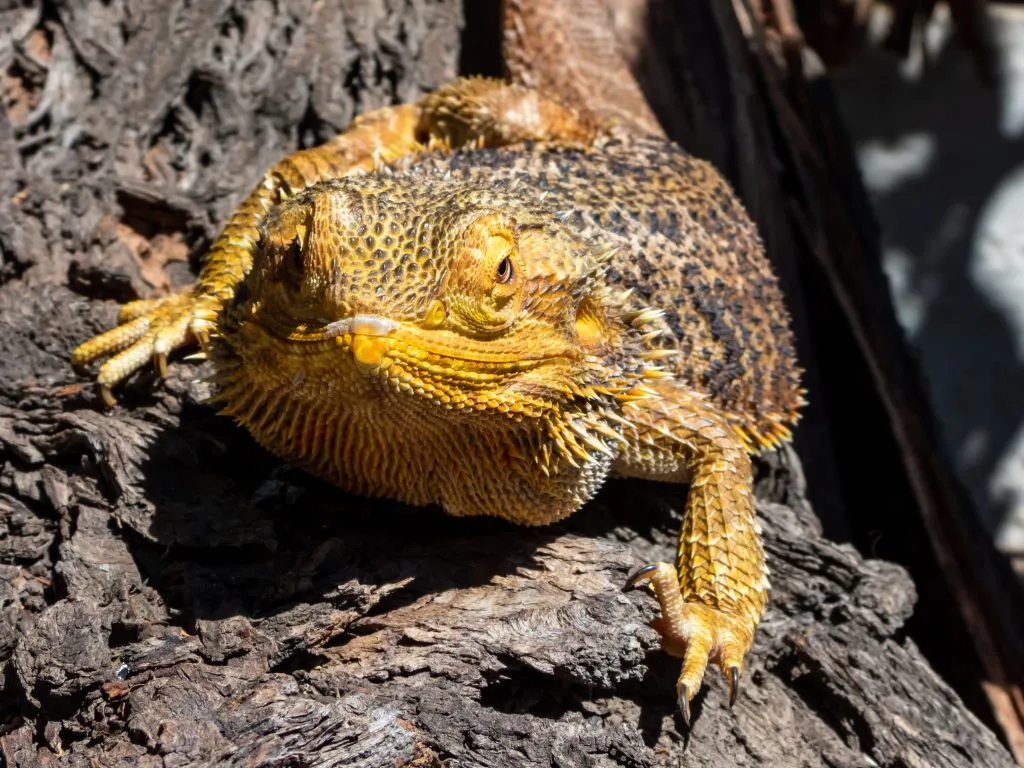
Constipation is a very common disorder that happens when a beardie has trouble digesting
Keep in mind that a bearded dragon’s bowel movement frequency is going to depend on its age and some other factors like its diet and UVA/UVB light exposure.
The expected frequency at which you should expect your bearded dragon to have a bowel movement is:
- Babies: baby bearded dragons are expected to poop a lot because of their faster metabolic rate. You can expect your baby beardie to poop around 1 to 3 times per day. If your baby bearded dragon does not poop for a whole day, then it is constipated.
- Juveniles: juvenile beardies poop less often than babies, usually every 2 days, and they can poop even less regularly as they reach adulthood. However, it is not normal if your juvenile beardie goes for more than 7 days without a bowel movement.
- Adults: the normal poop schedule of adult bearded dragons can vary from reptile to reptile, and it can be affected for many reasons. Therefore, it is normal for some adult bearded dragons to poop as often as once per day or as infrequently as once per week. More than one week without a bowel movement is considered constipation.
The most common causes of constipation are dehydration and/or an unbalanced diet; but, in some cases, constipation may also happen due to suboptimal basking areas, inadequate substrate, stress, or some diseases such as nutritional secondary hyperparathyroidism or kidney enlargement, among others.
When constipation occurs, blood can appear in your bearded dragon’s poop as a result of the effort they have to make to try to push out the feces from its colon.
Other signs of constipation in bearded dragons may include:
- Lack of energy
- Loss of appetite
- Not defecating
- Enlarged abdomen
- Rounded mass that can be palpated in their abdomen (colon)
If you think your beardie is constipated, you can try giving it a warm 100 °F (37.7 °C) water bath for 30 minutes to 2 hours, followed by a belly massage to help activate its digestive system.
You can do the massage by rubbing your fingers slowly and gently toward your beardie’s vent.
If that did not work out, you can try some of the other home remedies that we listed in this article on why your beardie isn’t pooping.
After having tried everything you can, if your beardie is still not pooping, then it is time to get it to a reptile veterinarian for further evaluation and testing.
Impaction

Impaction happens when a large amount of poop gets build-up in your bearded dragon’s digestive system, blocking its intestines as a result. Thus, your pet becomes unable to have an effective bowel movement.
This can be caused by an unbalanced diet, incorrect temperature settings, or inadequate substrate.
In this case, blood can appear in your bearded dragon’s poop or rear as a result of the irritation and constant straining they have to make to try to force all the remaining poop out.
Signs of impaction can include:
- Lack of energy
- Sudden weight gain
- Bloating
- Regurgitation
- Trouble walking
- Loss of function of the back legs
- Bump in the lower spine
Impaction can be life-threatening if not addressed in a timely manner. If you suspect your beardie may have impaction, please take it to a reptile vet immediately.
Eating Substrate
Bearded dragons may accidentally eat substrate when feeding themselves; but, sometimes, they eat it on purpose when they are lacking minerals from their diet, usually calcium.
Bearded dragons who are not receiving adequate amounts of calcium will try to compensate for this deficiency by eating loose substrate, including sand, soil, or gravel.
As a consequence, beardies can get constipation or even impaction from eating large amounts of unsafe substrate.
To prevent this, provide your pet with a little bowl filled with shredded sepia bones so they can get the extra calcium they need from there.
Furthermore, bearded dragons that eat an unsuitable substrate have a larger risk of internal injuries and subsequent bleeding. Avoid using materials like sand, soil, wood chips, coconut coir, crushed walnut shells, gravel, or rocks.
Instead, you can use a reptile carpet, a rubber shelf liner, or ceramic titles as safe substrates for your pet’s enclosure.
Internal Injury
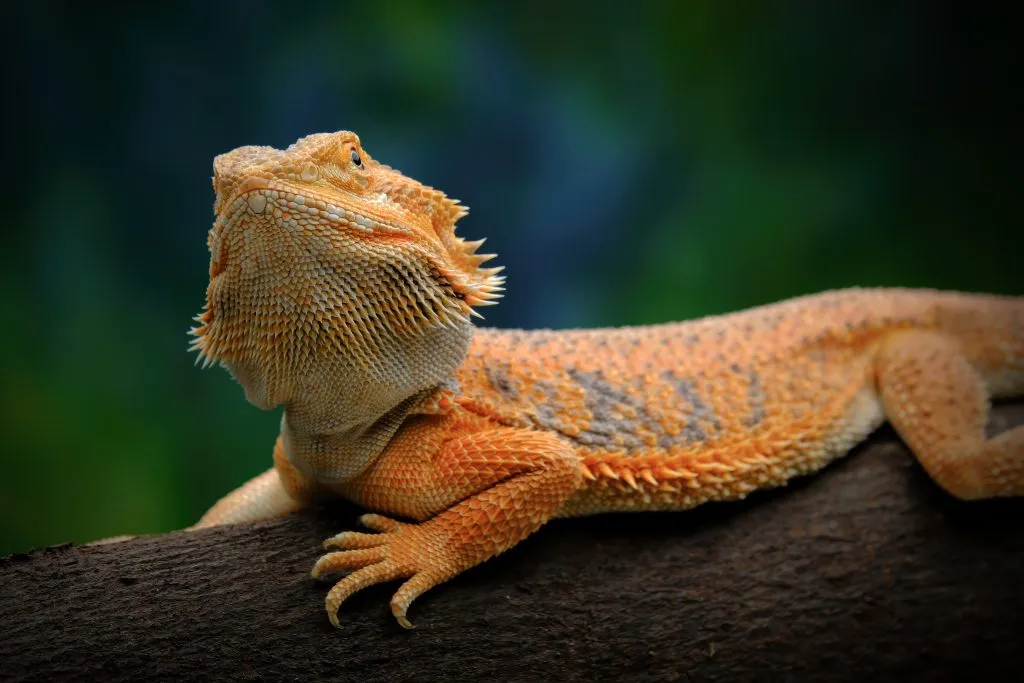
Internal injuries can happen as a result of direct or indirect trauma to your pet’s digestive organs, which can lead to internal bleeding; and therefore, bloody stools.
Direct trauma can happen when your bearded dragon eats unsuitable substrate that can harm or even puncture its digestive organs. The same can happen when you feed them insects that have very sharp shells and legs.
In some cases, beardies may have a significant mouth injury that can result in them passing some blood through their feces. In this case, you will notice the color of the blood is dark red, not bright red.
Indirect trauma can happen as a result of blunt force trauma like falling or getting attacked by some other animal. Bearded dragons love heights and climbing, which means they have a higher risk of falling.
Indirect trauma can cause your beardie to have a fracture or even a ruptured organ.
Signs of internal injury include:
- Bleeding from the anus
- Bleeding from the mouth
- Breathing difficulties
- Lethargy
- Lack of appetite
- Swollen abdomen
If your pet sustained a fall or any other trauma, and you notice one or more of the signs of internal injury, take it to the reptile vet immediately.
Prolapse
Although it is an infrequent reason, bloody stools can also happen due to a prolapse.
A prolapse happens when your pet’s internal tissues slip out of its body through the vent, and it is generally caused by excessive straining; which is frequently secondary to parasites, constipation, etcetera.
If your beardie has a prolapse, it is usually going to be very evident in plain sight. You will see a pink or purple mass of raw tissue protruding from your pet’s anal area.
In this case, please take your pet to the reptile vet immediately for emergency attention. Prolapses are very painful and can be life-threatening when left untreated.
What To Do If There Is Blood In Your Beardie’s Poop
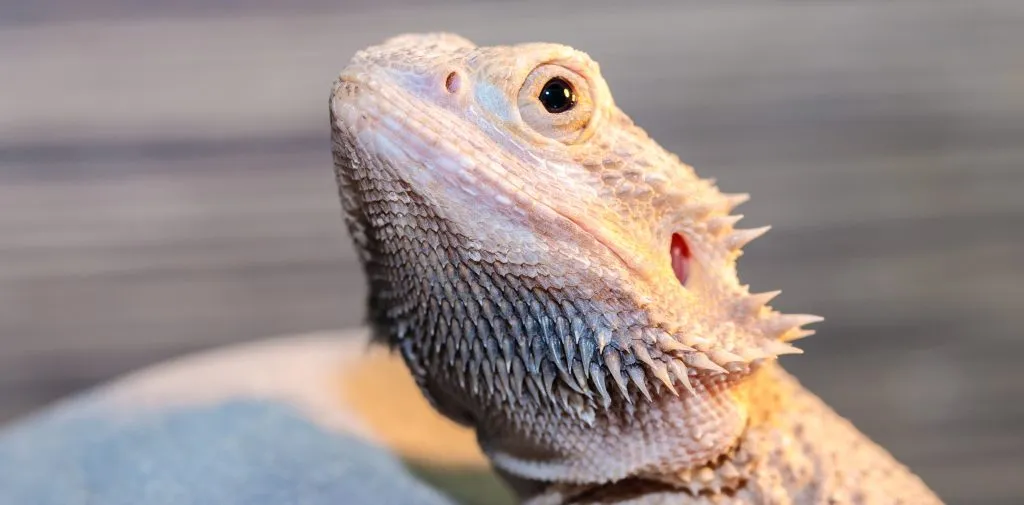
After reading all the possible causes for bloody depositions that we previously listed in this article, you should know what to look for in the particular case of your bearded dragon.
But, if that seems confusing, or you are still unsure about the steps you need to take after noticing some red color that might be blood in your beardie’s poop, here is a list that can guide you in what to do next:
- First, think about what were the last foods your pet ate recently. If you fed it some raspberries or beets, then this can be the cause of the change of color in your pet’s poop.
- Next, do a thorough physical exam of your pet’s body. Look for any signs of sickness or injuries.
- Then, assess your beardie’s behavior. Is your pet acting normal, or it seems lethargic? Is it eating as always? Is it basking as usual? Is it spending more time hiding?
If your pet seems healthy and is acting normal, then you should start monitoring its bowel movements for a few days to see if you can notice any more red color in it.
In any case, a single bloody deposition should not be something to worry about.
At this time, you can give a bath to your bearded dragon to help it relax and get adequate hydration. If your beardie is constipated, a bath can also help it to relieve itself.
On the other side, if you notice your pet starts acting strange, is not eating, is hiding more than usual, seems bloated, has diarrhea, is having trouble walking, or has a visible injury; then take it to the reptile vet as soon as possible.
- Enchi Ball Python: A Unique and Stunning Morph of Python regius - March 27, 2025
- Emerald Tree Monitor: The Enigmatic Green Guardian of the Rainforest - March 26, 2025
- The Egyptian Cobra (Naja haje): A Fascinating Serpent - March 25, 2025
